The first thing that attracts the human eye are colors, fonts, and the size or shape of any design. In context to Logo Design, these categories are crucial to create a welcoming and curious feel towards whatever audience is targeted. When a company wants to make its logo, it should be true to its brand while also making sure it catches the niche market. For example, if a renovation company were to make a neon-colored logo with multiple colors and a font of Audiowide (a font option on Google Docs) this would probably give a very discomforting sight to the audience and most probably would seem like a brand logo for a circus and would not be taken seriously.
Brand logos represent the company and have a huge effect on the company and the audience it aims to attract. So to leave out any part that was not considered important, think again because every part makes a huge impact. We can look at the iconic brands and how their logos have engraved their way into our minds and memories, even though certain brands’ logos recreate their logos after years, their old logos are still seen as iconic because of the huge impact they made in their business and how it attracted their customers. For example, Revlon changed its brand logo a couple of times, however, staying true to its colors and shape and being linear. However, every time the logo gave off a dominating beauty of color and authority.
Therefore, taking the above examples, Brand Logos are crucial for a Company to put themselves out there and provide an inviting feel for the customers and employees as well. When we talk about the psychological aspect behind brand logos, this is where business and psychology work together to form the ultimate eye-catching Logos that will stay in style for as long as ever.
Logo Design Colors
When we look at iconic brand logos such as McDonald’s or ColourPop ( a cruelty-free makeup brand) we can see how their colors complement each other and the renowned yellow M from the McDonald’s logo you can see from a distance alone on its advertisement pole. And with ColourPop you can see the ethereal feel with white and lavender shades surrounding the logo.
Coming back to the color selection, let’s look further into the McDonald’s logo, although it may look like the traditional yellow M and red background to help make the yellow M pop, however, the psychology behind it is that red is characterized as a stimulating color that associates with being active while the color yellow is universally known as a happy color. Most of the time McDonalds also uses the M as a smiley face. Another research was conducted on this logo and it has shown that the color red increases one’s heart rate. Although it may have a different effect on every individual, these were the most consistent results from the research. These colors are also welcoming to people of all ages.
Certain colors have a very deep impact on an individual’s brain. The ventral optical lobe is the part of the brain that catches color and either converts it into an emotion that is welcoming or the opposite.
When creating a logo, look at authentic color charts to help choose which colors would complement each other and make the most out of your logo.
According to a study, these are what certain colors represent based on emotions:
- Blue logos give feelings of confidence and success
- Green logos produce an encouraging feeling toward oneself and the environment, they also give a sense of durability and sustainability
- Purple logos evoke feelings of femininity and charm, it also gives an ethereal feel
- Pink logos give a sense of youth and fashion
- Yellow logos imply feelings of fun and modernity
- Red logos create a feeling of self-assurance and expertise and sometimes a dominant feel
Feeling like there’s too much to handle? Read about “8 Ways TO Stay Creative Under Pressure.”
Typefaces/Fonts
When we talk about fonts, it feels like it may not be the most important factor when it comes to brand logos, however that is wrong. Fonts come in all types of sizes, styles, and shapes as well. Some fonts, if used in the right sense with the right logo, can develop a posh and creative feel towards the audience making sure that the font style is readable and understandable. Some fonts can make people dizzy and that is a fact for example, if the font style is too cursive and joint then it would give a hard time to read and make sense of the words.
Some logos have bold fonts, creating a sense of confidence and authenticity for the audience. Here are a couple of examples of bold font brand logos; Adidas, Mont Blanc, and Nutella.
Not all brand logos should have bold fonts as it would not suit the logo or what the company is producing. For example, if a company is well known for its high-end, well-aged wine, a brand logo that has bold block letters with big spaces would not suit it, instead a typeface that is slightly cursive with a straight linear direction, would be the best giving it an expensive feel and would perfectly capture the targeted audience.
To learn more about typefaces and typography, read our blog “Typography: An Important Element In The Field Of Graphic Designing.”
Size and Shape of Logo Design
Logos come in various shapes and sizes, these provide a symbolic impact on the customers and create the entire tone of the brand logo. Certain shapes such as circles, triangles, linear, or rectangles can either complement your entire logo design or cause wrong impressions towards the audience.
Here are some explanations as to what shape or symbol represents what outcome to an individual’s mind:
- Circle logos create an uplifting emotion and give a happy feel, it also implies a sense of comfort and makes a more soft inviting tone as compared to a shape that has harsh pointy edges
- Triangle-shaped logos give a dominant and engaging feel and create a bold direction. Companies such as Adidas are active and sportswear merchandise, captures their audience well enough such as those who strive towards success or are active
- Square logos represent strength, safety, and security. Some brands such as Tiffany and Co. are known for their authentic diamond key symbol that symbolizes love and unity. Its background color is a distinct turquoise color which will stick to the person’s mind initiating a priming effect.
The symbolic effect of Brand logos
Symbols are often used to signify the brand by making that symbol iconic and in memory of the consumer. The most common symbols used in brand logos are animals, plants, or certain key objects.
For example, if a company produces outdoor camping gear, probably the most catchy and expected logo design type would be for the logo to include the silhouette of a mountain at the back with a camper climbing up the mountain and the brand name on the base of the mountain, giving the impression or strength. The shape of the logo would be in a triangle which would further represent bravery towards the logo design.
Some logo designs that are directed towards mental health or so would incorporate green, purple, or yellow colors, flowers or plants, and a soft text design, and the logo shape could either be linear or in the shape of a circle again together this would represent compassion, strength, and certainty.
How Logos Have a Psychological Impact towards Customers
Symbols
We know how the use of symbols has an impact on improving a logo, depending on where it may be relevant of course, however, symbols can create a source of connection with reality, where a person’s mind would automatically connect the object in real life settings engaging them back to that specific brand logo and company. Before words or letters, people see the bigger picture or the object, these simple shapes represent abstract symbols and can capture the essence and tone of the entire brand logo.
Uniqueness
Once a brand establishes its logo, it should try to reach that level of differentiating itself from other competitor brands’ logos, while trying to be catchy and notable.
Priming Effect
In psychology, the term priming means when an individual is exposed to a certain stimulus, it may influence a response to a subsequent stimulus without a conscious guide. In simpler terms, this is when the name or in this case the brand logo influences a person’s immediate thoughts or actions. For example, if someone sees the color of anything else that has the combination of red and yellow, their mind would subconsciously think about McDonald or when you see the Yin-Yang shape, it would remind you of the Pepsi Logo. These factors heavily influence people’s perceptions and how they look at other objects unknowingly connecting them to a certain brand logo they have seen in the past.
Wondering how graphic designers manage to do all of it? Learn what graphic designers do by reading “What Does A Graphic Designer Do?”
Conclusion
Looking into all these factors and probably more, these are the most eye-catching aspects of a brand logo. People define objects from what they see and what vibes a certain object or in this case a brand logo. When a logo would have a subconscious or psychological effect on the consumer, it could connect to the individual personally and would tell a lot about one’s identity and the company’s as well. Also, if you want an eye-catching logo that makes the audience stop, reach out to the design experts at Logovent. From brilliant designs to rates that fit all the budget types, there’s everything you’ll ever need.





